RBSE Solutions for Class 11 Physics Chapter 5 Laws of Motion
Rajasthan Board RBSE Solutions for Class 11 Physics Chapter 5 Laws of Motion Textbook Exercise Questions and Answers.
Rajasthan Board RBSE Solutions for Class 11 Physics in Hindi Medium & English Medium are part of RBSE Solutions for Class 11. Students can also read RBSE Class 11 Physics Important Questions for exam preparation. Students can also go through RBSE Class 11 Physics Notes to understand and remember the concepts easily.
RBSE Class 11 Physics Solutions Chapter 5 Laws of Motion
RBSE Class 11 Physics Laws of Motion Textbook Questions and Answers
Question 5.1.
Give the magnitude and direction of the net force acting on
(a) a drop of rain falling down with a constant speed.
(b) a cork of mass 10 g floating on water.
(c) a kite skillfully held stationary in the sky.
(d) a car moving with a constant velocity of 30 km.h-1 on a rough road.
(e) a high-speed electron in space far from all material objects, and free of electric and magnetic fields.
Answer:
(a) Since the drop of rain is falling with constant speed i.e., acceleration is zero. Therefore according to F = ma, the net force will be zero.
(b) The cork is floating on water, its weight is balanced by force buoyancy i.e., upthrust. Therefore net force acting on cork is zero.
(c) Since kite is held stationary in space, therefore the net force on kite is zero.
(d) The car is moving with constant speed, therefore its acceleration is zero. Hence net force acting on car will be zero.
(e) Since the electron is moving with high speed in space and it is not acted upon by gravitational, electric and magnetic forces. Therefore net force on electrons will be zero.

Question 5.2.
A pebble of mass 0.05 kg is thrown vertically upwards. Give the direction and magnitude of the net force on the pebble:
(a) during its upwards motion.
(b) during its downward motion.
(c) at the highest point where it is momentarily at rest. Do your answers change if the pebble was thrown at an angle of 45° with the horizontal direction?
Ignore air resistance.
Answer:
(a) During upward motion force F = mg = 0.05 x 10 = 0.5N. It will be vertically down-wards
(b) Similarly during downward motion,
force F = mg = 0.05 x 10 = 0.5 N vertically downwards.
(c) Even at highest point, the force
F = mg = 0.05 x 10 = 0.5 N vertically downwards.
If the pebble is throw at an angle of 45° with horizontal, even then the answers will not change.
Question 5.3.
Give the magnitude and direction of the net force acting on a stone of mass 0.1 kg.
(a) Just after it is dropped from the window of a stationary train.
(b) Just after it is dropped from the window of a train running at a constant velocity of 36 kmh-1.
(c) Just after it is dropped from the window of a train accelerating with 1 ms-2.
(d) Lying on the floor of a train which is acclerating with 1 ms-2, the stone being at rest relative to the train.
Neglect air resistance throughout.
Answer:
(a) In this situation F = weight of the stone
or F = Mg = 0.1 x 10 = 1N (downwards)
(b) Since, no force is applied on the stone due to uniform motion of train, therefore F = Mg = 0.1 x 10 = 1 N (downwards)
(c) Due to accelerated motion of the train some additional force will be experienced by the stone in horizontal direction i.e. F'= Ma = 0.1 x 1 = 0.1N
since the stone is dropped, therefore F' will not be active. Hence, resultant active force on the stone F = Mg = 1N (downwards)
(d) In this situation, the weight of the stone is balanced by the reaction of floor on the stone. Therefore net active force on the stone is
F = ma = 0.1 x 1 = 0.1 N (in horizontal direction)
Question 5.4.
One end of a string of length l is connected to a particle of mass m and the other to a small peg on a smooth horizontal table. If the particle moves in a circle with speed v, the net force on the particle (directed towards the centre is):
(i) T
(ii) T - \(\frac{m v^2}{l}\)
(iii) T + \(\frac{m v^2}{l}\)
(iv) 0
T is the tension in the string. [Choose the correct alternative]
Answer:
Where T is tension in string. We see,
Fnet = T - Fc
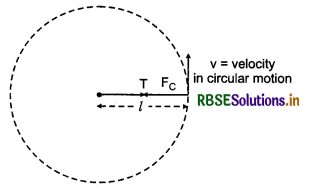
Here, v is constant.
∴ T - Fc = 0 ∴ T - Fc
Since required centripetal force is provided by the tension of the string. Hence option (i) is correct.
Question 5.5.
A constant retarding force of 50 N is applied to a body of mass 20 kg moving initially with a speed of 15 ms-1. How long does the body take to stop?
Answer:
Given: F = -50 N; m = 20kg; u = 15ms-1; v = 0; t = ?
Acceleration, a = \(\frac{\text { Force }}{\text { Mass }}=\frac{-50}{20}\) = - 2.5 ms-2
Now, from equation v = u + at
0 = 15 + (-2.5)t = 15 - 2.5t
or 2.5t = 15
∴ t = \(\frac{15}{2.5}\) = 6s.
Question 5.6.
A constant force acting on a body of mass 3.0 kg changes its speed from 2.0 ms-1 to 3.5 ms-1 in 25 s. The direction of the motion of the body remains unchanged. What is the magnitude and direction of the force?
Answer:
Given u = 2ms-1; v = 3.5ms-1; t = 25s
∵ v = u + at
∴ 3.5 = 2 + a x 25
or 250 = 3.5 - 2 = 1.5
∴ a = \(\frac{1.5}{25}\) = 0.06 ms-2
Mass of the body M = 3 kg
∴ The force acting on the body,
F = Ma ⇒ F = 3 x 0.06 = 0.18 N
Since the force applied in the direction of motion increases the velocity. Therefore the direction of force will be in direction of motion.

Question 5.7.
A body of mass 5 kg is acted upon by two perpendicular forces 8 N and 6 N. Give the magnitude and direction of the acceleration of the body.
Answer:
Given: m = 5 kg; F1 = 8N; F2 = 6N, a = ?
Resultant force
\(\vec{F}=\vec{F}_1+\vec{F}_2\)
∵ \(\vec{F}_1 \perp \vec{F}_2\)
∴ Magnitude of resulant force
F = \(\sqrt{F_1^2+F_2^2}=\sqrt{8^2+6^2}=\sqrt{64+36}\)
or F = \(\sqrt{100}\) = 10 N
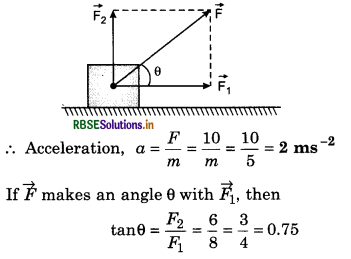
or θ = tan-1(0.75)
or θ = 36.86°
Question 5.8.
The driver of a three wheeler moving with a speed of 36 km h-1 sees a child standing in the middle of the road and brings his vehicle to rest 4.0 s just in time to save the child. What is the average retarding force on the vehicle? The mass of the three wheeler is 400 kg and the mass of the driver is 65 kg.
Answer:
Given: u = 36 kmh-1
= 36 x \(\frac{5}{18}\) ms-1 = 10 ms-1
v = 0; t = 4s; m = 400 + 65 = 465kg,
∵ v = u + at ∴ 0 = 10 + a x 4
or 4o = -10 ⇒ a = -\(\frac{10}{4}\) = -2.5 ms-2
∴ Retardation a = 2.5 ms-2
Hence the retarding force,
F = ma = 465 x 2.5
F = 1162.5 N
Question 5.9.
A rocket with a lift-off mass 20,000 kg is blasted upwards with an initial acceleration of 5.0 ms-2. Calculate the initial thrust (force) of the blast.
Answer:
Given: m = 20,000 kg = 2 x 104
\(\frac{\Delta v}{\Delta t}\) = 5 ms-2
or a = 5 ms-2; g = 10 ms-2
∵ The initial thrust (force) of the blast lifts the rocket with initial acceleration ‘a’ along with over coming the force of gravity which has acceleration g. Therefore if initial thrust is F, then equation of motion of the rocket,
F - mg = ma ⇒ F = mg + ma
or F = m(g + a) = 2 x 104(10 + 5) = 2 x 104 x 15
= 30 x 104 = 3 x 105 N
Question 5.10.
A body of mass 0.40 kg moving initially with a constant speed of 10 ms-1 to the north is subject to a constant force of 8.0 N directed towards the south for 30 s. Take the instant the force is applied to be t = 0, the position of the body at the same time to be x = 0, and predict its position at t = -5 s, 25 s, and 100 s.
Answer:
Given: m = 0.40 kg; u = 10 ms-2 towards north;
F = -8.0 N towards for 30 seconds
or F = - 8.0 N towards the south for 0 ≤ t ≤ 30 s
So, the retardation produced on the body due to the force F is
a = \(\frac{F}{m}=\frac{-8.0 \mathrm{~N}}{0.40 \mathrm{~kg}}\) = -20 ms-2; 0 ≤ t ≤ 30 s
Now the distance travelled by the body under these conditions is given by,
S = ut + \(\frac{1}{2}\)at2
or x = ut + \(\frac{1}{2}\)at2
Thus, (i) For t = 0; x = 0
(ii) For t = -5 s
a = 0 (before t = 0, it has no acceleration)
∴ x = 10 x (-5) + 0 = -50 m
(iii) For t = 25 s; a = -20 ms-2
∴ x = 10 x 25 - \(\frac{1}{2}\) x 20 x 25 x 25
or x = 250 - 6350 = -6000 m
x = -6 km
(iv) For t = 30 s
x30 = ut + \(\frac{1}{2}\)at2
= 10 x 30 -\(\frac{1}{2}\) x 20 x 30 x 30
= 300 - 9000
= -8700 m
= -8.7 km
and v1 = u + at = 10 + (-20) x 30
or v1 = -590 ms-1
(v) The force is active only for 30 s. Therefore, for 100 - 30 = 70 s, the acceleration becomes zero i.e., a = 0
x70 = ut + \(\frac{1}{2}\)at2
= (-590) x 70 + \(\frac{1}{2}\) (0) x (70)2
= -41300 + 0
= -41300 m
Therefore, total distance travelled by the body after 100 s is
x = x30 + x70 = -8700 - 41300
= -50,000 m
= -50 km
Question 5.11.
A truck starts from rest and accelerates uniformly at 2.0 ms-2. At t = 10 s, a stone is dropped by a person standing on the top of the truck (6 m high from the ground). What are the (a) velocity, and (b) acceleration of the stone at t = 11s? (neglect air resistance)
Answer:
Given: v0 = 0; a = 2ms-2; t = 10 s;
∴ Final velocity in X-direction
vx = u + at = 0 + 2 x 10
or vx = 20 ms-1
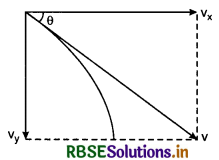
(a) After dropping the stone, it moves for time = 11 - 10 = 1 s
∴ The vertical velocity of the stone
vy = u + gt = 0 + 10 x 1 = 10 ms-1
or vy = 10 ms-1
∴ Resultant velocity of the stone,
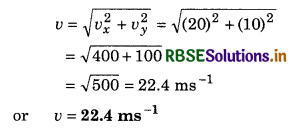
If resultant velocity makes an angle θ with horizontal, then
tan θ = \(\frac{v_y}{v_x}=\frac{10}{20}=\frac{1}{2}\)
∴ θ = tan-1(\(\frac{1}{2}\))
(b) When the stone is dropped, then only gravitation acceleration acts on it.
∴ Acceleration at t = 1 s,
a = g = 10 ms-2

Question 5.12.
A bob of mass 0.1 kg hung from the ceiling of a room by a string 2 m long is set into oscillation. The speed of the bob at its mean position is 1 ms-1. What is the trajectory of the bob if the string is cut when the bob is (a) at one of its extreme positions, (b) at its mean position?
Answer:
(a) At extreme positions, the velocity of the bob is zero. Therefore on cutting the string at one of extreme position, the bob will fall freely under gravity. Therefore its path will be straight line i.e, the trajectory will be linear.
(b) At mean position of the bob its velocity is maximum and it is in horizontal direction. Therefore on cutting the string, the bob will adopt parabolic path.
Question 5.13.
A man of mass 70 kg stands on a weighing scale in a lift which is moving:
(a) upwards with a uniform speed of 10 ms-1.
(b) downwards with uniform acceleration of 5 ms-2.
(c) upwards with a uniform acceleration of 5 ms-2.
What would be readings on the scale in each case?
(d) What would be the reading if the lift mechanism failed and it hurtled down freely under gravity?
Answer:
In each case the weighing scale represents the reaction force.
(a) Lift is moving upwards with uniform speed therefore acceleration a = 0
∴ R = mg = 70 x 10 = 700 N
(b) When lift moves downwards with uniform acceleration ‘a’, then equation of motion,
mg - R = ma ⇒ R = mg - ma
or R = m(g - a) = 70(10 - 5) = 70 x 5N
or R = 350 N
(c) When lift moves upwards with uniform acceleration of 5 ms-2, then
R - mg = ma ⇒ R = mg + ma = m(g + a)
or R = 70(10 + 5) = 70 x 15 = 1050N
or R = 1050 N
(d) When lift falls freely, then a = g
∴ R = mg - ma = mg - mg = 0
or R = 0
Question 5.14.
Position-time graph of particle of mass 4 kg, is shown in figure. What is the (a) force on the particle for f < 0, t > 4s, 0 < t < 4 s? (b) impulse at t = 0 and t = 4 s? (Consider one dimensional motion only)
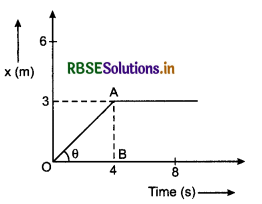
Answer:
(a) When t < 0, then graphical line is horizontal, therefore, particle is at rest. Hence the distance travelled will be zero and the magnitude of force acting on particle will also he zero.
When 0 < t < 4 s, the slope of graph OA is constant therefore during this time interval, the particle moves with uniform velocity which is obtained by the slope of the graph i.e.,
v = tanθ = \(\frac{A B}{O B}=\frac{3}{4}\) = 0.75 ms-1
In this case also, acceleration is zero, because, velocity is constant. Therefore, the magnitude of the force acting on the particle will he zero.
When t > 4 s, the graphical line becomes parallel to axis of time, which has its slope tan0° = 0 i.e., velocity v = 0. Therefore the particle will be at rest, obviously; therefore acting on the particle will also be zero.
(b) At t = 0 s, according to question u = 0 v = 0.75 ms-1;
m = 4 kg
∴ Impulse = Change in momentum
i.e. I = ∆p = m (v - u)
or I = 4 (0.75 - 0)
or I = 3 kg ms-1
At t = 4 s; u = 0.75 ms-1; v = 0
∴ Impulse I = m (v - u) = 4 (0 - 0.75)
= -3 kg ms-1
Question 5.15.
Two bodies of masses 10 kg and 20 kg respectively kept on smooth horizontal surface are tied to the ends of a light string. A horizontal force F = 600 N is applied on to (i) A, (ii) B along the direction of string. What is the tension in string in each case?
Answer:
(i) When force F is applied to A, then acceleration of the system
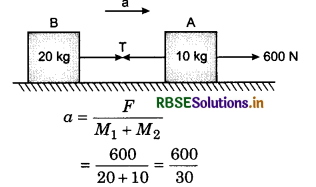
= 20 ms-2
Equation of motion of A.
F - T = MA . a
or 600 - T = 10 x 20 = 200
∴ T = 600 - 200
or T = 400 N
(ii) When force is applied to block B, then equation of motion of B.
F - T' = MB a
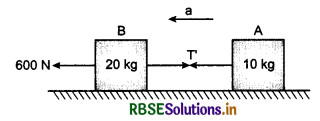
or 600 - T' = 20 x 20 = 400
∴ T' = 600 - 400
or T' = 200 N
Question 5.16.
Two masses 8 kg and 12 kg are connected at the two ends of a light inextensible string that goes over a frictionless pulley. Find the acceleration of the masses and the tension in the strings when the masses are released.
Answer:
Given: M1 = 8 kg;
M2 = 12 kg; g = 10 ms-2
Equation of motion of M1;
T - M1g = M1a
or T - 8 x 10 = 8a
or T - 80 = 8a ........................(1)
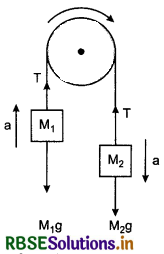
Equation of motion M2
M2g - T = M2a
or 12 x 10 - T = 12a
or 120 - T = 12a
On adding eqations (1) and (2),
120 - 80 = 8a + 12a
or 40 = 20a
∴ a = \(\frac{40}{20}\) = 2 ms-2
Substituting the value of a in equation (1),
T - 80 = 8 x 2 = 16
∴ T = 80 + 16 = 96 N

Question 5.17.
A nucleus is at rest in the laboratory frame of reference. Show that if it disintegrates into two smaller nuclei, the products must move in opposite directions.
Answer:
Suppose the mass of nucleus is m and it is at rest. Therefore initial momentum = m x 0 = 0. If the masses of its products are m1 and m2 and their velocities are v1 and v2 respectively, then according to law of conservation of momentum:
Momentum before disintegration = Momentum after disintegration
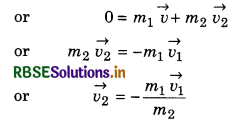
Here minus sign indicates the direction of \(\overrightarrow{v_1}\) and \(\overrightarrow{v_2}\) will be opposite to each other.
Question 5.18.
Two billiard balls each of mass 0.05 kg moving in opposite directions with speed 6 ms-1 collide and rebound with the same speed. What is the impulse imparted to each ball due to the other?
Answer:
Change in momentum of one ball,
\(\overrightarrow{\Delta p}=\overrightarrow{p_2}-\overrightarrow{p_1}=-m \vec{u}-m \vec{u}=-2 m \vec{u}\)
∴ ∆p = 2mu = 2 x 0.05 x 6
= 0.6 kg ms-1
∴ Impulse imparted to one ball,
I = ∆p = 0.6kg ms-1
Same impulse in magnitude will be imparted to other ball also.
Question 5.19.
A shell of mass 0.020 kg is fired by a gun of mass 100 kg. If the muzzle speed of the shell is 80 ms-1, what is the recoil speed of the gun?
Answer:
Before firing, the net momentum of the system = 0
After firing net momentum = m \(\vec{u}\) + M\(\vec{v}\)
where m and and M are the masses of gun and shell respectively and \(\vec{u}\) and \(\vec{v}\) are their velocities respectively.
∴ According to law of conservation of momentum.
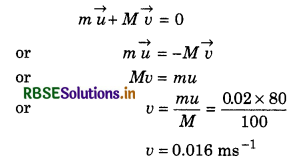
or Recoil velocity of the gun = 0.016 ms-1
Question 5.20.
A batsman deflects a ball by an angle of 45° without changing its initial speed which is equal to 54 km h-1. What is the impulse imparted to the ball? (Mass of the ball is 0.15 kg).
Answer:
Impulse = Change in momentum = Resultant momentum
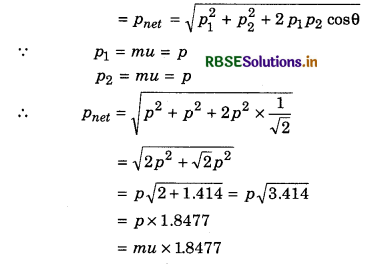
= 0.15 x 54 x \(\frac{5}{18}\) x 1.8477
= 4157 \(\frac{\mathrm{kg} \text { meter }}{\mathrm{sec}}=\frac{4.16 \mathrm{~kg} \text { meter }}{\mathrm{sec}}\)

Question 5.21.
A stone of mass 0.25 kg tied to one end of a string whirled round in a circle of radius 1.5 m with a speed of 40 revolution per min in a horizontal plane. What is the tension in the string? What is the maximum speed with which the stone can be whirled around if the string can withstand a maximum tension of 200 N?
Answer:
Given: m = 0.25 kg; r = 1.5 m;
Frequency n = 40 cycle min-1 = \(\frac{40}{60} \frac{\text { cycle }}{\text { s }}\)
n = \(\frac{2}{3}\) cs-1
∴ ω = 2πn = 2π x \(\frac{2}{3}=\frac{4 \pi}{3}\) rad s-1
ω = 1.33 π rad s-1
∴ Tension in the string T = Fc = mrω2
T = 0.25 x 1.5 x 1.33π x 1.33π
= 0.25 x 1.5 x 1.33 x 1.33 x 9.86
= 7.89 N
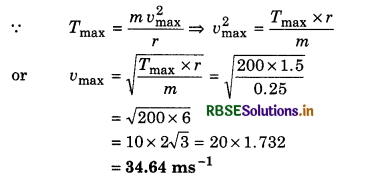
Question 5.22.
If in question 5.21, the speed of the stone is increased beyond the maximum permissible value and the string breaks suddenly, which of the following correctly describes the trajectory of the stone after the string breaks:
(a) The stone moves radially outwards
(b) The stone flies off tangentially from the instant the string breaks.
(c) The stone flies off at an angle with the tangent whose magnitude depends on the speed of the particle?
Answer:
Option (b) is correct, according to newton’s first law of motion, the direction of motion does not change in absence of external force. Hence this option correctly describes the trajectory.
Question 5.23.
Explain why:
(a) a horse cannot pull a cart and run in empty space.
(b) passengers are thrown forward from their seats when a speeding bus stops suddenly.
(c) It is easier to pull lawn mower than to push it
(d) a cricketer moves his hands backwards while holding a catch.
Answer:
(a) In empty space the mutual force (action and reaction) between the horse and the cart cancel each other. It means there is no external force in empty space. Thus the system (horse and cart) remains in its initial state i.e., at rest. Hence, a horse cannot pull a cart and run in empty space.
(b) When a bus is moving with uniform speed, the passengers are also moving with the same speed. On account of this motion, the inertia of the body tends to move the body in forward direction. Now when a speeding bus stops suddenly, the lower part of the body also stops suddenly as they are in contact to the floor of the bus and seats of the bus (force of friction between feet and the floor of the bus) but upper part of the body still tends to remain in forwards motion because of the inertia of motion of the body. As a result passengers are thrown forward from their seats when a speeding bus stops suddenly.
(c) When an object is pulled by applying a force at an angle with horizontal, then vertical component of this force (pull) reduces the effective weight of the object (i.e., less than actual weight) and less normal reaction R. Hence the force of friction (f ∝ R) reduces. Therefore less force (pull) is required to move the object.
Just opposite mechanism happens while pushing the obejct. Hence it is easier to pull lawn mower than to push it.
(d) A cricketer moves his hands backwards while holding a catch so that the time of impact to complete a catching increases. The increase in time results into small impulse. Thus force that acts on his hands reduces and it does not hurt him.
Additional Exercises
Question 5.24.
Figure shows the position time graph of x(m) a body of mass 0.04 kg. Suggest a suitable physical context for this motion. What is the time between two consecutive impulses received by the body? What is the magnitude of each impulse?
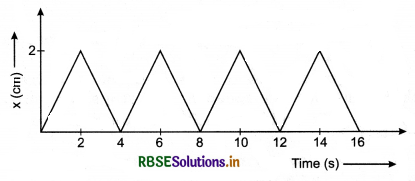
Answer:
Given: Mass of a body, m = 0.04 kg, graph (position-time) shown in given figure indicates that displacement of the body is changing with time.
From t = 0 to t = 2 s,
Velocity of the body is,
u = \(\frac{2-0}{2-0}\) = 1cms-1 = 0.01 ms-1
From t = 2 s to t = 4 s, velocity of the body,
u' = \(\frac{0-2}{4-2}\) = -1 cm s-1 = - 0.01 ms-1
After every 2 seconds, the direction of the Velocity of the body gets reversed. Therefore, the body receives impulse after every 2 seconds. This type of motion can be considered as the collision of the ball in between the two walls repeatedly.
Now magnitude of each impulse = Change in linear momentum after each interval of 2 seconds
or I = mu - mu' = (0.04 x 0.01) - (0.04) x (-0.01)
or I = 8 x 10-4 kg ms-1
Question 5.25.
Given figure shows a man standing stationary with respect to a horizontal conveyor belt that is accelerating with 1 ms-2. What is the net force on the man? If the coefficient of static friction between the man’s shoes and the belt is 0.2, upto what acceleration of the belt can the man continue to be stationary relative to the belt? (Mass of the man = 65 kg).
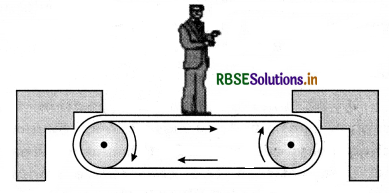
Answer:
Given: Mass of the man m = 65 kg
Acceleration of a horizontal conveyor belt a = 1ms-2.
∴ Acceleration of the man = a = 1ms-2
Therefore net force on the man is F = ma = 65 x 1 = 65N
This force F is acting along the direction of the motion of the conveyor belt.
Now coefficient of static friction between shoes and the belt = µs = 0.2
So the force of limiting friction between the man’s shoes and the belt,
(fs)max = µsR = µs . mg
Therefore the maximum force required for man to remain stationary on the belt
Fmax = (fs)max
or mamax =µs mg
∴ amax = µsg
0r amax = 0.2 x 10 = 2 ms-2
Question 5.26.
A stone of mass m tied to the end of a string revolves in a vertical circle of radius R. The net forces at the lowest and highest points of the circle directed vertically downwards are: (Choose the correct alternative).
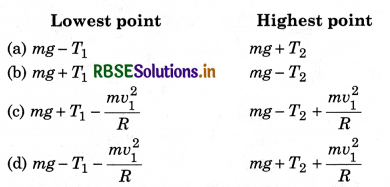
T1 and v1 denote the tension and speed at the lowest point. T2 and v2 denote the corresponding values at the highest point.
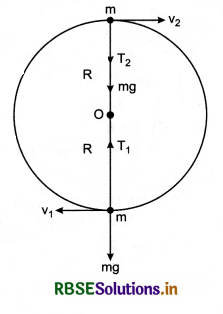
Answer:
Net force on the revolving particle is centripetal force which is required for circular motion.
1. At lowest point, the equation of motion,
T1 - mg = \(\frac{m v_1^2}{R}\)
At highest point, the equation of motion of particle,
T2 + mg = \(\frac{m v_2^2}{R}\)
Thus alternative (a) is correct.

Question 5.27.
A helicopter of mass 1000kg rises with a vertical acceleration of 15 ms-2.
The crew and the passengers weigh 300 kg. Give the magnitude and direction of the:
(a) force on the floor by the crew and passengers.
(b) action of the rotor of the helicopter on the surrounding air.
(c) force on the helicopter due to the surrounding air.
Answer:
Total mass of crew and passengers and helicoptor
M = 300 + 1000= 1300 kg
Acceleration of helicopter a = 15 ms-2 (upwards)
(a) Equation of motion of passengers and crew
R - mg = ma ⇒ R = mg + ma = m(g+ a)
∴ Force on the floor of helicopter,
R = 300(10 + 15) = 300 x 25 = 7500 N (downwards)
(b) Action of the rotor of the helicopter on the surroundings
R' = M(g + a) = 1300 x (10 + 15) = 1300 x 25
= 32500N
(c) According to Newton’s third law of motion, the force applied by surrounds on helicopter = - the force applied by helicopter on surrounds
= 32500 N (upwards)
Question 5.28.
A stream of water flowing horizontally with a speed of 15 ms-1 gushes out of a tube of cross-sectional area 10-2 m2 and hits a vertical wall nearby. What is the force exerted on the wall by the impact of water, assuming it does not-rebound?
Answer:
The volume of water striking the wall per second
V = v x A = 15 x 10-2 = 0.15 m3s-1
∴ Mass of water striking the wall per second
M = V.ρ = 0.15 x 103 = 150kg
∴ Initial momentum of water,
p1 = m.v = 150 x 15 = 2250kg ms-1
Final momentum of water = 0
∴ Force applied by water on the wall,
\(\vec{F}=\frac{\overrightarrow{\Delta p}}{\Delta t}=\frac{0-2250}{1}\) = -2250 N
∴ F = 2250 N
Question 5.29.
Ten one-rupee coins are put on top of each other on a table. Each coin has a mass m. Give the magnitude and direction of:
(a) the force on the 7th coin (counted from the bottom) due to all the coins on the top.
(b) the force on the 7 th coin by the eight coin.
(c) the reaction of the 6 th coin on the 7 th coin.
Answer:
(a) The force on 7 coin will be equal to weight of three coins situated on it i.e., F = 3 mg N
Where g is acceleration due to gravity
(b) Force on 7th coin by 8th coin
F = weight of three coin situated over it
= 3 mg N
(c) Reaction of 6 th coin on 7th coin
R = weight of 4 coins situated over it
= 4 mg N
Question 5.30.
An aircraft executes a horizontal loop at a speed of 720 km.h-1 with its wings banked at 15°. What is the radius of the loop?
Answer:
∵ tan θ =\( \frac{v^2}{r g} \Rightarrow r=\frac{v^2}{g \tan \theta}\)
Given: v = 720kmhr-1 = 720 x \(\frac{5}{18}\) = 200 ms-1
θ = 15° ∴ tan θ = tan 15° = 0.2679
g = 10 ms-2
∴ r = \(\frac{200 \times 200}{10 \times 0.2679}\)
= 15.2 x 103 m = 15.2 km
Question 5.31.
A train runs along an unbanked circular track of radius 30 m at a speed of 54 kmh-1. The mass of the train is 106 kg. What provides the centripetal force required for this purpose? The engine or the rails? The outer or the inner rail? Which rail will wear out first, the outer or the inner rail? What is the angle of banking required to prevent wearing out of the rail?
Answer:
Here r = 30 m; v = 54 km h-1 = 54 x \(\frac{5}{18}\) = 15 ms-1; m = 106 kg
The centripetal force required for the purpose is provided by the lateral thrust by the outer rail on the flanges of the wheels. By Newton’s third law of motion, the train exerts an equal and opposite thrust on the outer rail, causing it wear and tear.
tan θ = \(\frac{v^2}{r g}=\frac{15 \times 15}{30 \times 10}\) = 0.7653
∴ Banking angle θ = tan-1(0.7653)
or θ = 37.4°

Question 5.32.
A block of mass 25 kg is raised by a 50 kg man in two different ways as shown in figure. What is the action on the floor by the man in the two cases? If the floor yields to a normal force of 700 N, which mode should the man adopt to lift the block without the floor yielding?
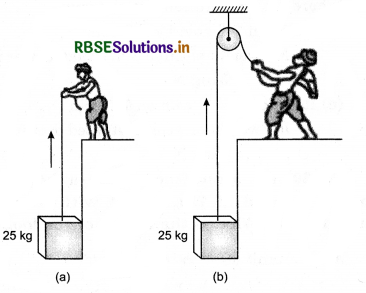
Answer:
Mass of the block (to be raised) m1 = 25 kg.
Mass of the man M2 = 50 kg
Magnitude of the force applied by the man to lift block against the force of gravity is,
F = m x g = 25 x 10 = 250N
Weight of the man.
W = m2g = 50 x 10 = 500N vertically downwards.
Case 1. When block is raised by the man as shown in figure (b).
Here direction of the force applied by the man to lift the block is vertically upwards. Thus according to Newton’s third law, the reaction on the floor is downward direction. Hence the net normal force acting on the floor by the man in this mode of lifting the block is
N = W + F = 500 + 250 = 750N
Case II. When the block is raised by the man as shown in figure (b)
Here direction of the force applied by the man to lift the block, is vertically downwards. Hence the reaction on the floor will be in upward direction. Therefore the net normal force acting on the floor will be,
N' = W - F = 500 - 250 = 250N
According to the question, the floor can yield a normal force upto 700 N. So the second mode of lifting the block should be adopted by the man, in order to avoid the floor fielding.
Question 5.33.
A monkey of mass 40 kg climbs on a rope in figure, which can stand a maximum tension of 600 N. In which of the following cases will the rope break: the monkey.
(a) Climbs up with an acceleration of 6 ms-2?
(b) Climbs down with an acceleration of 4 ms-2?
(c) Climbs up with a uniform speed of 5 ms-1?
(d) Fall down the rope nearly freely under gravity?
(Ignore the mass of the rope)
Answer:
Given: Mass of the monkey m = 40 kg
Maximum limit of tension in the rope,
Tmax = 600 N
(a) When monkey climbs up with acceleration of a = 6ms-2
Due to upward accelerated motion of monkey, the net weight of the monkey during motion
W = mg + ma = m(g+ a)
= 40(10 + 6) = 40 x 16 = 640 N
Therefore the tension of the rope in this case will be
T = 640 N
∵ T > Tmax
Therefore the rope will break.
(b) When monkey climbs down with acceleration
a = 4 ms-2
Then the applarent weight
W = mg - ma = m(g - a) = 40(10 - 4)
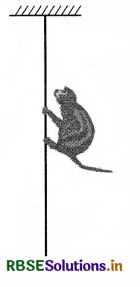
= 40 x 6 = 240N
∴ Tension in the rope
T = 240N
∵ T < Tmax
∴ Rope will not break.
(c) When monkey climbs up with uniform speed of 5 ms-1, then acceleration a = 0
∴ Apparent weight of the monkey
W = mg = 40 x 10 = 400 N
∴ Tension in the rope
T = 400 N
In this case also T < Tmax
∴ The rope will not break
(d) When monkey falls down nearly freely, then
a = g
Thus the net weight
W = mg - ma = mg - mg
or W = 0
∴ T = 0
In this case the rope will not break.
Question 5.34.
Two bodies A and B of masses 5 kg and 10 kg in contact with each other rest on a table against a rigid wall (see figure). The coefficient of friction between the bodies and the table is 0.15. A force of 200 N is applied horizontally to A What are (a) the reaction on the partition? (b) the action reaction forces between A and 2J? What happens when the wall is removed? Does the answer to (b) change, when the bodies are in motion. Ignore the difference between µs and µk.
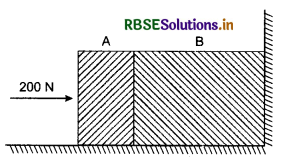
Answer:
Given: Mass of the body A
mA = 5 kg
Mass of the body B, mB = 10 kg
Coefficient of friction between the bodies and the table is
µ = µk = µs = 0.15
Horizontal applied force on A(figure)
F = 200 N
(a) Since the wall is rigid, so no motion is produced in both the bodies due to horizontally applied force F, Therefore, the self adjusting normal force on B by the partition (reaction) is equal to 200 N.
(b) Assuming that their is no friction between contact surface of the bodies A and B. Also there is no motion. Hence the action-reaction forces between A and B is equal to the horizontally applied force F i.e., 200 N.
When the wall is removed: The bodies are free to move horizontally, unless force of friction is not greater than the horizontal applied force of friction on the bodies A and B is,
fAB = µ(mA + mB)g
= 0.15(5 + 10) x 10 = 0.15 x 15 x 10
or fAB = 22.5 N
∵ fAB < F
It means that some net force (= F - fAB) is acting on the bodies.
Therefore, acceleration produced on the bodies A and B, is
a = \(\frac{\left(F-f_{A B}\right)}{\left(m_A+m_B\right)}=\frac{(200-22.5)}{(5+10)}=\frac{177.5}{15}\)
or a = 11.8 ms
Hence, the bodies A and B start moving with an acceleration of 11.8 ms on the removal of rigid wall.
When the bodies are in motion: An applied force 'F' is producing a common acceleration ‘a’ on both the bodies A and B. But due to the presence of friction, the same amount of force is not necessarily transfered from one body (A) to another body (B). Force of friction on body A
fA = µmA g = 0.15 x 5 x 10 = 7.5 N
Thus, force transfered on body B by A is
FAB = F - fA = 200 - 7.5 = 192.5 N
Now, when the bodies A and B are in motion with a common acceleration ‘a’. Therefore,net force exerted by the body A on the body B (partition) is FAB = FAB - mA.a
or F'AB = 192.5 - 5 x 11.8 = 133.5N
Hence, the action reaction forces between A and B when the bodies are in motion is equal to 133.5 N.
Question 5.35.
A block of mass 15 kg is placed on a long trolley. The coefficient of static friction between the block and the trolley is 0.18. The trolley accelerates from rest with 0.5 ms-2 for 20 s and then moves uniform velocity. Discuss the motion of the block as viewed by (a) stationary observer on the ground, (b) an observer moving with the trolley.
Answer:
Given: Mass of the block, m = 15 kg
Coefficient of static friction between the block and the trolley, µ = 0.18
For first 20 seconds: acceleration of the trolley is a = 0.5 ms-2
After wards, trolley starts moving with uniform velocity, 1.e., a = 0
During the accelerated motion of trolley force acting on the block (which is placed on the trolley) in the direction of motion of trolley is,
F = ma = 15 x 0.5 = 7.5N
The block will slide over the surface of the trolley if the force acting on it is greater than the force on limiting friction.
Here force of limiting friction.
(fs)max = µs mg = 0.18 x 15 x 10
or (fs)max = 27N
∵ (fs)max > F
Therefore, the block placed on a long trolley will not slide over the surface of the trolley.
(a) Stationary observer on the ground:
Observation: Trolley is moving with respect to the stationary observer on the ground. And the block placed on the trolley is also moving with the trolley without sliding over the surface of the trolley.
(b) Obsever moving with the trolley
Observation: When the trolley is accelerating (for first 20 seconds) or moving with uniform velocity (after 20 seconds), the box remains to its position. For the observer, trolley as well as block are stationary.
Question 5.36.
The rear side of a truck is open and a box of 40 kg mass is placed 5 m away from the open end as shown in figure. The coefficient of friction between the box and the surface below it is 0.15 on a straight road, the truck starts from rest and accelerates with 2 ms-2. At what distance from the starting point does the box fall of the truck? (Ignore the size of the box).
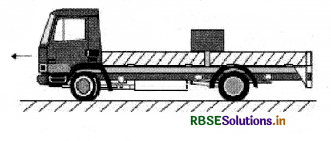
Answer:
Force experienced by the box,
F = ma = 40 x 2 = 80N
Force of friction available
Ff = µs mg = 0.15 x 40 x 0.8 = 58.8N
∴ Net force acting on the box
F' = F - Ff = 80 - 58.8
F'= 21.2N
∴ Acceleration, a = \(\frac{F^{\prime}}{m}=\frac{21.2}{40}\) = 0.53 ms-2
Now from equation,
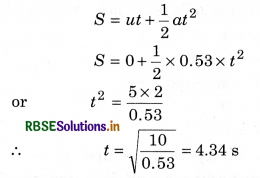
∴ The box will fall off the truck in 4.34 s.
The distance travelled by the truck in this time,
x = ut + \(\frac{1}{2}\) at2 = 0 + \(\frac{1}{2}\) x 2 x (4.34)2
= 18.84 m
Question 5.37.
A disc revolves with a speed of 33\(\frac{1}{3}\) rev min-1 and has radius of 15 cm. Two coins are placed at 4 cm and 14 cm away from the centre of the record. If the coefficient of friction between the coins and the record is 0.15, which of the coins will revolve with the record?
Answer:
The coin can revolve with the record only when the required centripetal force is provided by the force of friction otherwise the coin will slip off the record i.e.,
Ff ≥ Fc
or µmg ≥ mrω2
or µg ≥ rω2 .....................(1)
For first coin: r = 4cm = \(\frac{4}{100}\) m
frequency n = 33\(\frac{1}{3}\) cycle mm-1 = \(\frac{100}{3 \times 60}\) cs-1
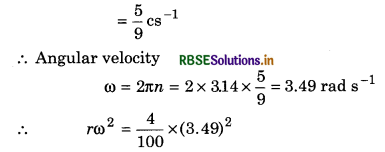
or rω2 = 0.49 ms-2
And µg = 0.15 x 10 = 1.5 ms-2
Since µg > rω2
∴ This coin will revolve with the record.
For second coin: r = 14 cm = \(\frac{14}{100}\) m = 0.14 m
and ω = 3.49 rad s-1
∴ rω2 = 0.14 x (3.49)2 = 1.705 ms-2
and µg = 1.47 ms-2
∵ µg > rω2
Therefore this coil will not revolve with record and it will slip off the (record) disc.

Question 5.38.
You may have seen in circus, a motorcyclist driving in vertical loops inside a death well (a hollow spherical chamber with holes, so the spectators can watch from outside). Explain clearly why the motorcyclist does not drop down when he is at the uppermost point, with no support from below. What is the minimum speed required at the uppermost position to perform a vertical loop if the radius of the chamber is 25 m?
Answer:
At the top of death well (spherical chamber with holes),the motorcyclist does not fall down because the weight of motorcycle and motorcyclist is consumed in providing the required centripetal force at the top of vertical-circular path.
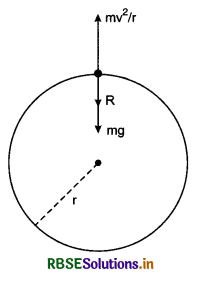
∴ R + mg = \(\frac{m v^2}{r}\) ......................(1)
Where R is normal reaction and r is the radius of the circuit. For minimum possible velocity at highest point R = 0.
∴ From equation (1)
mg = \(\frac{m v^2}{r}\)
∴ vmin = \(\sqrt{r g}=\sqrt{25 \times 10}\)
or vmin = 15.8 ms-1
Question 5.39.
A 70 kg man stands in contact against the inner wall of a hollow cylindrical drum of radius 3 m rotating about its vertical axis with 200 rev. min-1. The coefficient of friction between the wall and his clothing is 0.15. What is the minimum rotational speed of the cylinder to enable the man to remain stuck to the wall (without falling) when the floor is suddenly removed?
Answer:
The normal reaction of wall in horizontal direction provides the required centripetal force i.e.,
R = \(\frac{m v^2}{r}\) = mrω2
Force of friction acting upwards balances the weight of the body.
If f ≤ µR or mg ≤ mrω2
⇒ \(\frac{g}{\mu r}\) ≤ ω2
or ω2 ≥ \(\frac{g}{\mu r}\)
∴ Minimum angular velocity of rotation
ωmin = \(\sqrt{\frac{g}{\mu r}}=\sqrt{\frac{10}{0.15 \times 3}}\) = 4.667 rad s-1
or ωmin = 4.667 rad s-1
Question 5.40.
A thin circular loop of radius R rotates about its vertical diameter with an angular frequency ω. Show that a small bead on the wire loop remains at its lowermost point for ω ≤ \(\sqrt{g / R}\). What is the angle made by the radius vector joining the centre to the head with the vertical downward direction for ω = \(\sqrt{2 g / R}\)? Neglect friction.
Answer:
Suppose, the radius vector joining the centre O and the bead, makes an angle θ with vertical diameter. If N be the normal reaction of ring on bead. N can be resolved in two normal components.
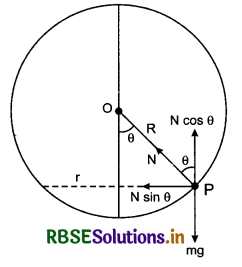
(i) N cos θ - vertically upwards
(ii) AT sin θ - in horizontal direction. Vertical component N cos θ balances the weight mg of the bead and horizontal component N sin θ provides centripetal force.
∴ mg = N cos θ ..................(1)
mrω2 = N sin θ .................(2)
Radius of circular and path of bead.
r = R sin θ
∴ m(R sin θ)ω2 = N sin θ
or mRω2 = N
∴ From equation (1),
mg= mRω2 cos θ
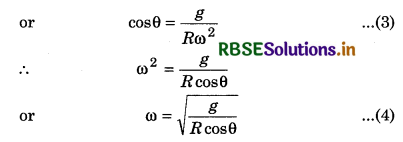
For the bead to remain in the lowermost position θ = 0° and cos θ = 1
Hence, ω = \(\sqrt{\frac{q}{R}}\) .....................(5)
Thus the bead will remain in lowermost position if,
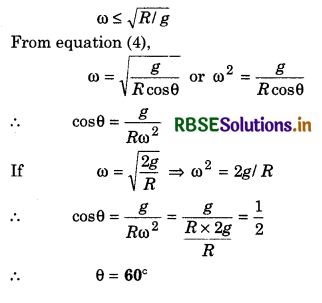

- RBSE Class 11 Physics Important Questions Chapter 4 Motion in a Plane
- RBSE Solutions for Class 11 Physics Chapter 15 Waves
- RBSE Solutions for Class 11 Physics Chapter 14 Oscillations
- RBSE Solutions for Class 11 Physics Chapter 13 Kinetic Theory
- RBSE Solutions for Class 11 Physics Chapter 12 Thermodynamics
- RBSE Solutions for Class 11 Physics Chapter 11 Thermal Properties of Matter
- RBSE Solutions for Class 11 Physics Chapter 10 Mechanical Properties of Fluids
- RBSE Solutions for Class 11 Physics Chapter 9 Mechanical Properties of Solids
- RBSE Solutions for Class 11 Physics Chapter 8 Gravitation
- RBSE Solutions for Class 11 Physics Chapter 7 System of Particles and Rotational Motion
- RBSE Solutions for Class 11 Physics Chapter 6 Work, Energy and Power